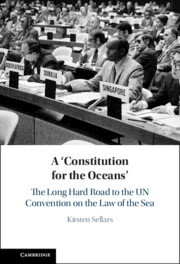Book contents
- A ‘Constitution for the Oceans’
- A ‘Constitution for the Oceans’
- Copyright page
- Contents
- Foreword
- Abbreviations
- 1 End of the Old Order
- 2 Old Freedoms, New Rights
- 3 North, South, East and West
- 4 A Conference Collapses
- 5 Internationalising the Seabed
- 6 Passage through Straits
- 7 The Archipelagic Concept
- 8 New International Orders
- 9 The Bitter End
- Afterword
- Bibliography
- Index
- A ‘Constitution for the Oceans’
- A ‘Constitution for the Oceans’
- Copyright page
- Contents
- Foreword
- Abbreviations
- 1 End of the Old Order
- 2 Old Freedoms, New Rights
- 3 North, South, East and West
- 4 A Conference Collapses
- 5 Internationalising the Seabed
- 6 Passage through Straits
- 7 The Archipelagic Concept
- 8 New International Orders
- 9 The Bitter End
- Afterword
- Bibliography
- Index
Summary
Throughout the various conferences addressing the law of the sea, states shaped and reshaped legal concepts relating to the oceans. They invented the ‘continental shelf’, ‘transit passage’, the ‘exclusive economic zone’, ‘archipelagic waters’ and the ‘seabed’. They reformulated the contiguous zone and fishing limits. And with a single stroke of a pen, they shrank the high seas by a third. Then, in 1994, just before the 1982 convention was about to enter into force, the UN General Assembly, prodded along by the United States, passed the ‘Implementation Agreement’, which amended the seabed regime set out within it. Now, over four decades after signature, new geopolitical forces will inevitably generate pressure for further changes to the law governing the sea.
Keywords
- Type
- Chapter
- Information
- A ‘Constitution for the Oceans' , pp. 323 - 332Publisher: Cambridge University PressPrint publication year: 2025

